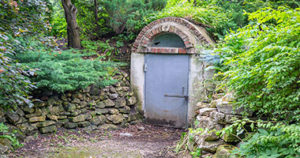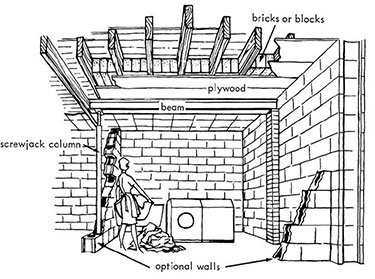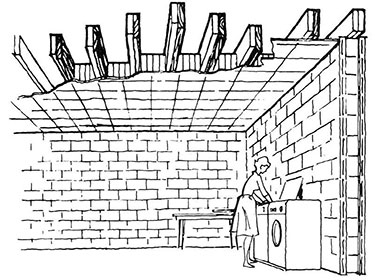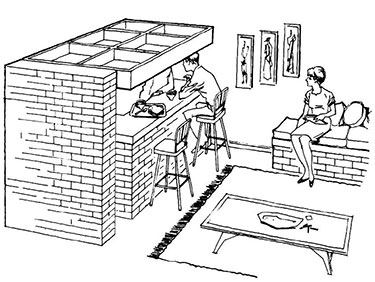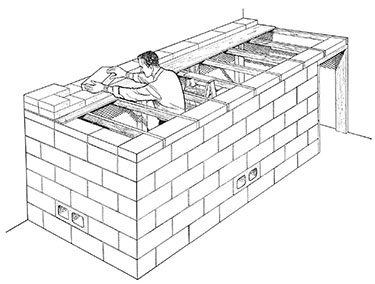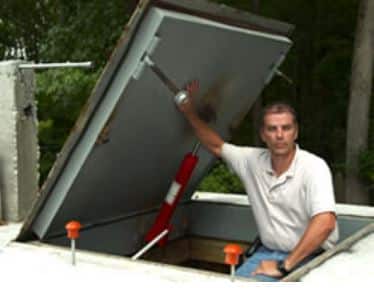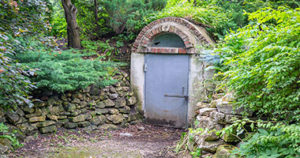
NOW is the best time for it, and not a moment too soon!
That’s why today I want to go over ALL your DIY Bunker options. From cheap DIY Bunkers to expensive ones – with ALL the Pros and Cons for each.
Because everyone should have a plan when an invasion or cataclysmic event happens.
We’ll be covering the following DIY Bunker topics:
- What Is A Bunker
- 5 Main Types of Bunkers
- Why You Should Build A DIY Bunker
- 9 Homemade Bunkers To Expensive (Pros / Cons)
- Key DIY Bunker Basics
What Is A Bunker
The term “Bunker” comes from the Scottish word for “bench, seat”. This is odd because that is NOT what I think when I hear the word “bunker”.
However, it was also used as the shortened form “bunk” which was used to describe a “sleeping birth”.
And the Old Swedish term “bunke” meant “boards used to protect the cargo of a ship”.
So, if you combine these original ideas of a “protected sleeping quarter” you can see how this term evolved into the modern idea of a “survival bunker”.
To be clear, a bunker IS NOT a “She-Shed” or a “Man-Cave”. It’s NOT a backyard hut where ladies’ have lunch or “the guys” watch the big game while eating finger sandwiches or chicken wings.
A bunker is a personal self-defensive fortification.
One that should be well-built to withstand entry from anyone who intends you harm.
Most are often located underground to:
1) remain hidden (i.e., you can’t attack what you don’t know is there)
2) avoid any above-ground dangers (bombing, nuclear fallout, infections, other humans, etc.)
The bottom line:
The primary goal in a homemade bunker is to protect the ones you love. And to survive an extended period of danger in a safe (often underground) location.
There Are 5 Main Types Of Bunkers
1. Industrial
These were designed to protect industries essential to the German government during WWII.
They were primarily used as mining sites, data storage centers, food storage areas, and occasionally used as living quarters.
2. Trench
This bunker is a smaller structure made of concrete and is partly dug into the ground as part of a trench system.
They were crude, open-aired-shelter to provide some protection for soldiers during Trench Warfare.
Staying hunkered down in the trench prevented soldiers from being sitting ducks for machine-gun fire from the enemy.
3. Munitions Storage
A munitions bunker held explosives and was typically built into the side of a hill. They were not designed for human occupancy.
4. Artillery
This was a secure place for weapons and ammunition. These types of bunkers were usually built on coastlines for large-scale wars.
5. Personal Survival Bunkers
Personal bunkers are often attached to homes or located on personal property. This helps to protect regular folks from bombing raids, nuclear fallout, or severe weather.
Today, those who want to live a resilient life, use these bunkers to protect themselves from:
- Tornadoes / Hurricanes / Wildfires
- Major Food & Water Scarcity
- Foreign Occupations / Civil War
- Widespread Civil Unrest
- Nuclear Bombs / Fallout
- Deadly Viruses / Diseases
Basically, a DIY underground bunker is the ultimate bug-out location ON YOUR OWN PROPERTY!
One where you can immediately shield yourself from ANY above-ground conflict.
Why You Should Build A DIY Bunker
Let’s face it, preparing for a future catastrophe isn’t cheap.
You must spend your hard-earned money on the right equipment and supplies. This investment is made not just to survive but to thrive in a variety of catastrophes.
That’s why we acquire guns and buy ammo, right? It’s why we spend money on Ham radios and building bug-out bags, get-home bags, and TFAKs.
And the super-rich can afford a high-tech bunker. Something that makes your BEST vacation look like a dump. But the rest of us need to build our own DIY bunkers on the cheap.
All you need to focus on is making sure your DIY bunker is safe and secure. And that CAN BE AFFORDABLE!
9 Homemade Bunkers To Expensive (Pros / Cons)
Now let’s investigate the different types of DIY bunkers you can construct. We will start with the cheap underground bunker and work our way up.
1. Inside Your House
Your house may already have the makings of a cheap DIY underground bunker. Some DIY bunker ideas for the home are:
- A crawl space under a home could be dug out and sealed
- And unused partition of a basement (safe or panic room)
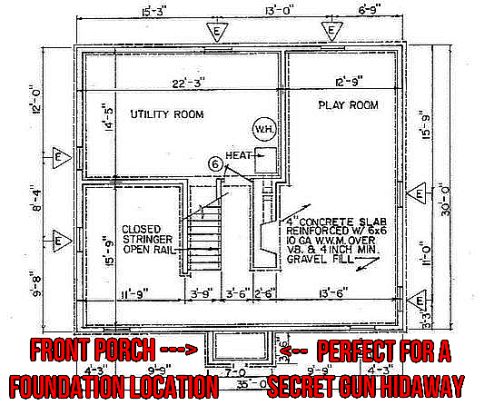
Many folks leave the area under a front porch as a hidden panic room.
This option is the most affordable of all the DIY Bunker options. But with THAT comes big tradeoffs.
Pros
- The rough structure is already built. You just need to make it livable and secure
- It’s right under the house so you can make a quick getaway
- It’s well hidden with a house over it
Cons
- It may not have a finished concrete floor
- Someone could gain access by breaking through the wood floor above
- Doesn’t give you distance with a separate bunker away from the home
Here’s a video series from Lumnah Acres, where he builds a “root cellar” in his unfinished basement. This same general idea can also be used for a “basement survival bunker:
Basement Shelter Designs
Basement areas are an ideal space to provide the best shelter against the fallout because they are already belowground. This gives them a natural earthen shield. If nuclear fallout is heading your way and you don’t have a shelter, head to a basement. You can provide additional shielding for your basement by constructing:
- Permanent shelters – turning part of your basement into a shelter area or by building a permanent shelter which might appear as a normal part of the home that also serve other purposes.
- Preplanned shelters – locating shielding materials so that should disaster strike, you can assemble your improved shelter quickly.
- Improvised shelters – by taking last-minute actions to assemble additional protection if an emergency warrants it.
There was an entire booklet published by the Department of Defense – Office of Civil Defense on this very subject. That too is available for download.
This booklet tells you the amount of protection your basement offers and what you can do to increase this protection to provide for your family’s safety. If you own a home with a decent basement, a fallout shelter inside your basement almost certainly makes the most sense compared to any other designs.
Concrete Block Shelter
This concrete block, compact shelter is an easy way to provide low-cost protection in your basement. A shelter as tall as the one pictured will not serve many additional purposes beyond maybe a kids’ playhouse, so I prefer some of the other designs here. Still, it’s a simple design that offers speedy construction.
Download the Concrete Block Shelter Plans here
2. Backyard Root Cellar
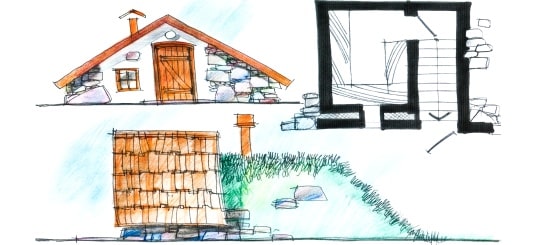
And it’s not attached to your house but still very close by.
Plus, it’s underground – so it naturally stays warmer in the winter and cooler in the summer. It can also protect you from bomb blasts and nuclear fallout.
A root cellar (by design) is made to keep fresh foods shelf-stable for long periods. And they don’t take up much space (depending on your space needs/family size).
Pros
- Small footprint
- Underground and on your own property
- Affordable (especially vs other DIY bunker options)
Cons
- Limited space, so might feel very cramped after a few days
- Not as hidden as true “underground bunkers”
Here’s a video that goes over why a small root cellar makes for a wise DIY Bunker:
3. Natural Cave or Burrow
If you own some land, perhaps you have a property with a natural void in the ground. This has the potential to be turned into a cheap bunker.
It may be an abandoned mine or an old den for wild animals but whatever the case, you can put it to good use.
When going into a cave, you need to be cautious. You don’t know what’s inside and how stable the roof and walls are. You’ll need structural support for it, but this is true of all bunkers.
You can even dig your own cave if your land is suitable.
Pros
- The basic structure is already made
- It usually has only one entrance to fortify
- It’s easy to camouflage
Cons
- You need to stabilize the walls and roof
- Water leaking in could be an issue
- Once a secure door is attached, you will need to tunnel out for ventilation
Here’s a video of a “makeshift” bunker built into a cave/burrow on public land:
4. Buried Culvert
Now we’re moving to more complicated DIY Underground Bunker builds. If this is the direction you’re going to go, I recommend you invest in some solid bunker plans.
Here’s a product that provides excellent bunker plans: Family Bunker Plans.
The culvert DIY bunker option is using a large, steel culvert buried as your escape pod.
These heavy-duty pipes are engineered with a corrugation profile. This design helps to maintain structural integrity and then buried in the ground.
Culverts can stand the force of the earth on top of it, so you are able to easily bury them to your required depth.
Like with all your DIY bunker ideas, you will have to build out the living and storage areas inside. And you will also need to weld both ends and fashion a proper exit going up to the surface.
Pros
- It’s a very strong structure that can be buried without stabilizing
- They come in various sizes and lengths
- They are affordable
Cons
- You only get a rounded long tube to work with for the build-out
- It has two wide openings that will need to be closed in
- Height and width could be an issue
5. Buried Shipping Container
It’s easy to find a shipping container to convert to a cheap DIY underground bunker. Used ones are rotated out of service all the time. And there are several companies that sell new and used ones for home use.
Often, folks add them to their property for secure storage of tools and equipment. But they can also have a greater purpose.
A shipping container already has the structure built and is made of steel. The doors are already steel too, making them very secure.
You will have to reinforce the sides and roof when burying it. That way, it won’t cave in and then you can build the interior how you like.
Pros
- The structure is already built
- Just dig a hole and drop it in
- You can easily connect multiple containers together
Cons
- Used containers may have toxic spills inside
- Metal walls and roofs aren’t strong enough to be buried without reinforcing them
- You aren’t building the outside structure so it will cost you more for the container
6. Above Ground Concrete Blocks
This is a cheap DIY underground bunker that you get to build piece by piece. The excavation won’t be as deep so if you don’t have access to a machine, you can hand dig it yourself.
This homemade bunker requires a solid, concrete footing. With a solid foundation, you can pour yourself with a bit of lumber and concrete. Then you build up bricks or cinderblocks layer by layer.
When the walls are complete, build a form inside for the roof with lots of rebars and pour the concrete on top.
You may want to add some rubber peel and stick it to the outside before you backfill. That way, you avoid any issues with water seepage. And then it is half in and half out of the ground, ready for you to camouflage.
Pros
- A great DIY project that you can build, block by block
- Excavation is easy because it is only halfway to the ground
- Can be built in a week
Cons
- Laying block is hard work, and you will need a scaffold to reach the top
- Lots of mortar and concrete mixing by hand or barrel mixer if you have one.
- You need to make sure the above-ground part of the structure is well hidden
7. Prefab Bunker
This is a bunker that has already been cast and is made of concrete with structural rebar in it. There are several companies that sell different sizes of bunkers.
This is still a DIY bunker because you need to dig the hole and pour a concrete base. Once the bunker is in place, you’ll need the exterior backfilled and interior buildout.
You’ll also have to put in a strong, steel door.
Pros
- You save time by not having to build the structure
- It’s built solid with thick, reinforced concrete
- This gets you into a bunker quick
- You can go any size you want if you have the room and money
Cons
- Because you aren’t building the structure, the cost is more expensive
- You need a strong base to place the bunker on
8. Hillside Bunker
A hill bunker takes advantage of a property that’s sloping or has a hill. This DIY underground bunker will take extra planning and know-how. Why? Because it can be dangerous to excavate.
As you start digging into your hill you will need to shore up the roof, so it doesn’t cave in. Pressure-treated wood or steel works well but make sure it is secure before going inside.
Once dug out and made sound you have a great bunker that can only be penetrated from the front. This is where you should form a concrete entrance with a steel door, so no one is getting in.
Pros
- The outer structure is a natural hill
- No one can get in except through the main door
- You are using a natural background for your DIY bunker, and it easily blends in with the landscape
Cons
- You need an excavator and an operator who knows what they are doing
- This requires support from either timber, steel, shotcrete walls, pillars, or a combination
- It’s usually not completely hidden from view
- Ventilation is crucial, especially the further in you go
9. Luxury Bunker
Most of the bunkers above are bunker ideas that you can afford without too much cost. If you are looking to step it up a notch and you got money to burn, why not build in some luxury.
DIY Bunker doesn’t have to mean cheap. You can go online and find plans to construct your own multi-room bunker. And then buy your materials and get building.
Outside the structure still must be solid so it can be buried and out of sight. Inside is where your luxury starts.
You can make it look like a high-end home with full bedrooms and a state-of-the-art kitchen. You can even put it in a movie theatre and games room.
There will be extensive ventilation, heating, and electrical requirements. As well as challenges dealing with water and waste.
The ground is the limit so go as far as your money will take you.
Pros
- You can have all the bells and whistles
- There will be enough room to not go stir-crazy
- You can bring friends along with your family because you will have the room
- It will feel like a fallout vacation
Cons
- It’s going to take a lot of money to have a luxurious DIY bunker
- The build will take way more time than any other cheap DIY underground bunker project
10. Communal Bunkers
For a bunker on steroids, you can build an underground shelter community. A group with multiple bunkers attached and private residences with common areas.
You need to get a lot of people involved and ready to spend their money with you. It takes a shared vision, a willingness to compromise, and a community spirit.
There are companies out there already doing this but to buy in costs big dough.
DIY Bunker Basics
We are finishing off here with some vital information for all your DIY bunker builds. Whether you have a cheap underground bunker or a luxurious one, there are must-have items to build in and stock.
Electrical & Lighting
You need to bring in power from the grid or use off-grid solutions. Power is necessary for illuminating your DIY underground bunker at a minimum.
And if you want to power a water pump or a ventilation fan, you’ll also need power as well.
In small applications, you may be able to get by with a power station and some solar panels – like what I use when I go camping.
Ventilation
Everyone needs fresh air to survive. So, consider how you are going to access above-ground ventilation.
You’ll need an outlet vent with a small fan sucking the stale air out of the bunker. And an inlet-vent with a filter that will allow fresh air in from outside.
Make sure the filter is good enough for nuclear fallout, stockpile several, and make sure you can change them out easily.
Food & Water Storage
DIY bunker projects tend to be small so don’t forget you need lots of room for food and water.
Canned meats and freeze-dried foods are great as well as home-preserved food.
Make sure there is plenty of water to drink, wash, and bathe.
I recommend a minimum of 2 weeks of food and 2 weeks of water. If you can do more, great, but if you’re just getting started, now you have a target amount to shoot for.
- For water, I assume 1 gallon per person per day.
- For food, use the “Daily Calorie Requirement Estimates”.
Medical Supplies
If you are heading to your bunker, you may already be injured and need medical supplies to treat wounds.
Accidents while underground can happen too.
Have a robust IFAK kit (individual first aid kit) with lots of extra trauma supplies on hand.
My go-to medical kit vendor is MY MEDIC. They have high-quality kits for all skills levels and needs; from IFAKs (individual first aid kids) to ITAKs (trauma first aid kits) everything in between.
Gas Masks and Filters
Let’s be real, one of the major reasons you’re thinking about building a bunker is to survive a nuclear blast and fallout, right?
Well, what happens if you’re forced to go outside, for supplies, or in an emergency while it’s still dangerous to do so? That’s why everyone should own at least 1 gas mask and several filters.
My go-to gas mask vendor is MIRA SAFETY. If you don’t have any gas masks, get some on order right now.
If you wait, you won’t get one later, they sell out almost immediately at the start of a crisis (like in the spring of 2020 and the start of the Russian invasion of Ukraine).
Currency
You may not need any money while underground. But once you exit your DIY bunker for supplies or to reemerge into society, you need a way to buy things.
Cash is usually great but if things really go south, you should have gold or silver as a reliable backup.
That’s why I’m currently acquiring Silver Rounds through SD Bullion every month…
Entertainment
You can go stir crazy quick so consider what you want to do while in your DIY bunker.
TV and radio are great to keep up with the catastrophe above but they require electrical power…Same for music, unless, you make your own music via an acoustic guitar, harmonica, etc.
Make sure to have games for the kids and stock lots of physical books. Board games and card games are fun too as well as puzzles.
Side note: One of my all-time favorite strategy games is called – Forbidden Island.
I can play it for hours and never get bored.
Keep it Secret. Keep it Safe.
If you have the time, space, and budget to construct one of these shelter, lucky you! Once you’re done with it, you’ll have to resist the urge to show it off to your friends and neighbors. A secret shelter is a safe shelter.
Keeping your shelter secret is critical or, should you actually have to use it, you run the risk of people knocking on your door suddenly looking to become your subterranean roommate
Final Thoughts
Having a DIY bunker is an essential survivalist item you hope you never need.
But those who have one will be able to weather whatever shit storm comes their way!
Prepare, Adapt & Overcome,
“Just In Case” Jack
The post Best DIY Bunker ANYONE Can Build On A Budget appeared first on Skilled Survival.


